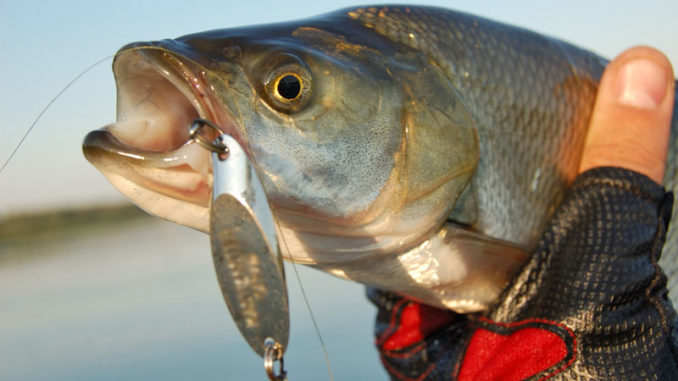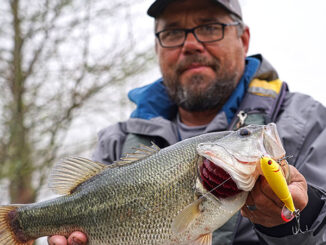
Subtle changes can lead to more bites
With cold water dictating a lot of what bass fishermen do in January, there’s one lure that can be counted on for plenty of bites: a jigging spoon.
Like any other class of lures, fishermen often make a few adjustments to the bait after opening the package, adjustments that might make a world of difference when it comes to tempting largemouth bass or striped bass to make a fatal mistake.
Bass pro Davy Hite of Ninety Six, S.C. — a two-time BASS Angler of the Year and the 1999 Bassmasters Classic champion — makes two major adjustments to jigging spoons if he feels like he can get a few extra bites.
“I use a Berry Spoon, which is made of a different material than most spoons,” Hite said. “It’s pliable, and you can fish it straight like it comes in the package, or you can put a slight bend in it that will give it an unusual action.
“I’ll replace the hook with a short-shank VMC treble hook, unless I know I’m going to be jigging around brush; then, I’ll switch it out to a single hook.
“The other thing I’ll do is, if fish are short-striking or I’m catching a lot of smaller fish, I’ll tie on a treble hook with a little feather or hair. I think that makes the fish focus more on the hook, and you won’t miss as many fish.”
A hook upgrade
Joel Richardson of Kernersville, N.C., a past FLW Tour winner and full-time guide, likes to use a treble hook on his spoons, and if the spoon comes with a good hook, he’ll use it. Otherwise, he’ll replace it with a better hook and often move up one hook size.
Like Hite, if he’s getting bites and missing hookups, Richardson will change out the hook to one with a feather or mylar, but he’ll often change out the hook and replace it with a red hook like a Daiichi Bleeding Bait hook.
“If I know I’m on fish and I’m missing some, I’ll change it out to a red hook, and sometimes, that makes a big difference,” he said.
Often, Richardson said, it’s the size of the bait or the way it’s jigged that make the biggest difference.
“I fish a spoon as the fish dictate it,” he said. “Lots of days, they want you barely hopping it; and then there are days they won’t hit it unless you jerk the heck out of it — and it can change over the course of the same day.
“I’ll fish different kinds of spoons — hammered or plain — and sometimes, I like to fish a spoon that’s wider than normal because it will move more water and fall a little slower.
“Another thing is the size of the spoon. I’ll fish from ¾-(ounce) down to 3/8-ounce. Sometimes that makes a difference, but I think it has more to do with the speed the bait falls than the size of the spoon.”
Fluorescent blue mono
Richardson always fishes spoons on monofilament line, and he likes fluorescent blue that’s invisible underwater but can help him see subtle bites.
“I like to fish fluorescent blue mono because I can see it,” he said. “Sometimes, you can lift your bait up and start to let it fall, and if you see it doesn’t fall, he might have it in his mouth. If you didn’t notice that, you’d miss him because he’ll spit it out after a second or two when he figures out that it’s not something he’s supposed to be eating.
One thing Richardson never does is tie his line directly to the spoon, even if it comes with a split ring.
“A spoon tied directly to your line will twist terribly, and if you’ve got line twist, the line might twist around your rod tip — and twisted line is weaker. Twist can turn 15-pound test into 8-pound test,” he said. “I’ll use a Sampo ball-bearing swivel with a snap, like a cross-lock snap. They’re a little bit expensive, but they’ll keep your line from twisting.”


